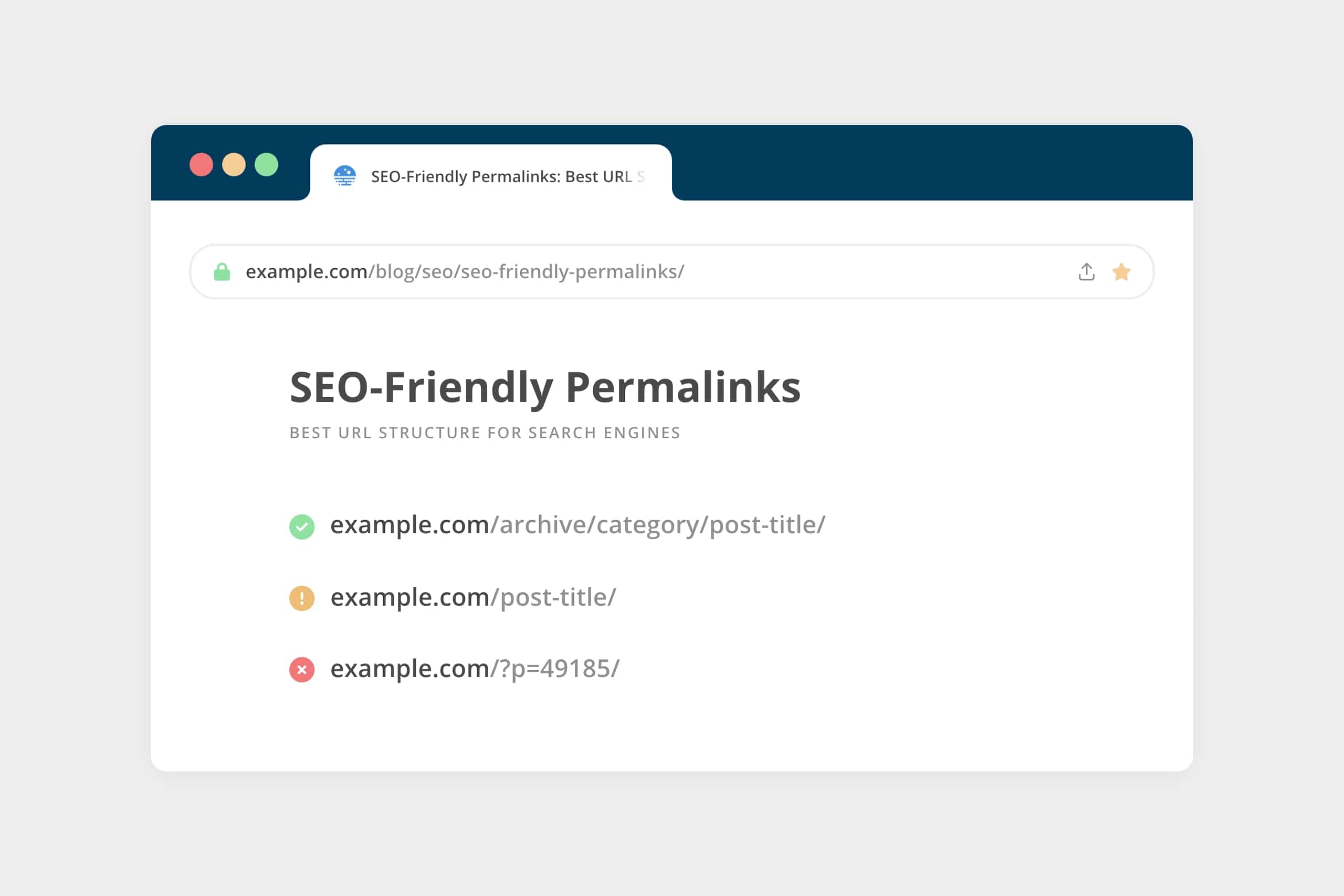
SEO-friendly permalinks: best URL structure for search engines: Have you ever wondered if URLs play a role in SEO performance? Spoiler alert, they absolutely do, and not only that but how URLs are structured can make or break any SEO campaign. In this post, we will cover the different types of SEO-friendly permalink structures and how you can be sure your URLs are a search engine's best friend.
What is an SEO-Friendly URL?
SEO-friendly URLs are those that are easy to comprehend for both humans and search engine bots and contain specific keywords that provide relevant information about the page's content. The hallmarks of SEO-friendly URLs include being (relatively) short, having relevant keywords, and using simple phrasing. They avoid punctuation and stop words like "very," "this," and "it," in addition to not solely relying on URL parameters that reference page IDs, such as /?p=2314&to=0c2j84h2vdksdsdkj.
An example of a non-SEO-friendly URL would be something like this:
example.com/core/index.php?p=994035Ironically, every time you enter a search query on search engines, they spit out URLs that are the opposite of SEO-friendly.
Why are SEO-Friendly URLs important?
It is absolutely essential to create SEO-friendly URLs for a variety of reasons. Doing so significantly facilitates web crawling and indexing by search engines, thereby greatly enhancing performance and visibility on search engines.
Not to mention, these types of URLs improve user experience by making them more readable and navigable—there's nothing more annoying than seeing example.com/index.php?id=29242424249&h=SEO&tdo=1x09wgnh3hc8wcb3hh53hf3c3f. I don't know about you, but that tells me less about my navigational location on a website than Google tells us about how they rank content (for all you non-SEO nerds out there, that's a serious burn because Google tells us nothing useful).
What is a Permalink Structure?
A permalink structure is an organizing system for website content in the form of a URL naming convention. It follows a hierarchical structure with the website domain, directories, and subdirectories describing the content on each web page. They can improve search engine optimization (SEO) performance by providing a clear hierarchy and a more accurate description of the page content compared to traditional, non-SEO-friendly URLs.
Put simply, when working with a dynamically-generated website—these are primarily websites that use some sort of content management system (CMS) like WordPress, Drupal, Shopify, etc.—URLs are generated based on the user-defined permalink structures. It's important to make the distinction between URLs and permalinks: permalink structures are the building blocks that determine how URLs will be generated, but not the other way around (URLs do not determine how a permalink structure will be generated).
Types of SEO-Friendly Permalink Structures
Since there are no industry standard types of SEO-friendly permalink structures, we've compiled a collection of the most common types we encounter daily. Each type has a rightful use case, but before we dive into more detail, let's quickly define each one:
- Date-Based: a URL structure organized by a year, month, and sometimes day hierarchy. A great example of this structure in action is the default URL for WordPress media library attachments.
- Category-Based: uses the post category to precede the post title in a URL (if applicable; typically only applies to archive-type posts/pages).
- Post/Page Title-Based: includes only the post title with no preceding terms (makes it difficult to establish a clear hierarchy).
- Archive-Hierarchal: uses the archive base page (usually just /blog/), category, and post title for a fully optimized URL structure (we've determined this the most effective strategy if used properly)
Now that we've briefly covered the four most popular types let's dive into each one's pros and cons.
Date-Based
example.com/wp-content/uploads/2023/05/image.jpgAs you can see, this structure—a sample taken from WordPress—organizes files and pages in a date-based fashion, meaning each item is sorted by a year and month, usually pertaining to its upload or creation date. This particular type can also work for archive posts that use timestamps:
example.com/news/2023/05/31/todays-news-article/In the above example, we added a day in addition to a month and year. This structure can be extra useful for websites that post several articles per day, such as news outlets and large corporations. On the other hand, a major downside to consider when using this permalink structure is that your URL real estate will be consumed by numbers instead of potentially valuable keywords.
Not only that but if your website content can't logically be hierarchically organized by post date, then this structure will do more harm than good to your SEO efforts. But even in those cases, this permalink structure will be far more effective than using a non-SEO-friendly structure like this one:
example.com/?p=2948Post/Page-Title-Based
example.com/post-title/If you thought the previous structure type was a bit confusing, this might be the type for you. With its minimalist approach, the post/page-title-based permalink structure is surely a step up from non-SEO-friendly URLs. If you often use long titles in your pages/posts and aim to target long-tail keywords, this is a great choice since you will have far more real estate to work with in the URL.
But before you jump to update your WordPress permalinks to this layout, let's discuss the cons. For starters, there is no hierarchy in this structure. Your top-level pages—About, Contact, Services, etc.—will appear to have the same level of importance as your press release about your newest employee. Now, not that those types of posts are important, but in terms of web content, static pages need to stay on a top level of their own to demonstrate authoritativeness and trustworthiness.
See also: What is E-E-A-T, and Why is it Important?
Keeping in mind that user experience is a big part of SEO ranking factors, users need to be able to know where they are on a website. Using breadcrumbs is a great way to help the user navigate, but reinforcing that hierarchy with a strong permalink structure can only help your UX.
Category-Based
Another extremely effective and popular permalink structure, the category-based layout, has proven time and time again to be a trustworthy path in one's SEO conquest. Take this URL, for example:
example.com/category/post-title/What we like about this structure is that it keeps the URL short and sweet but still has the potential to include some important keywords. Using this post as an example, let's look at a real-world example of this structure in use:
beyondbluemedia.com/seo/seo-friendly-permalinks/Right off the bat, users will be able to tell this post pertains to SEO—which is hopefully obvious at this point—and, more specifically, SEO-friendly permalinks. Users can also see that this post is a child page of the SEO category archive page.
Another positive to using this structure is that search engines can more easily determine the hierarchy of pages. When used in conjunction with effective XML sitemaps, search engines will rejoice to have a clear-cut path for crawling and indexing a website and its content.
Archive-Hierarchal
Based on our research and constant trial and error, we have determined this to be the most effective permalink structure for optimal SEO performance. Why? Well, let's break it down.
example.com/blog/category/post-title/Take a look at the above example. This structure includes the parent /blog/ page, the category archive page, and the post title itself. A big reason this structure is so impactful is that it creates a clear hierarchy that will match most auto-generated XML sitemaps, lets users know to which archives the post belongs, and adds a plethora of important keywords. Take this post once more, for example:
beyondbluemedia.com/blog/seo/seo-friendly-permalinks/Although this structure can be the most effective and useful, it's critical to understand the potential downsides. Many websites claim there will be a slight decrease in SEO performance when posts/pages have URLs exceeding a certain number of characters—most SEO plugins recommend no more than 100. So, if you aren't careful, your URL could easily become 200+ characters.
But, since there is no clear-cut way to A/B test this theory, we can safely take this with a grain of salt. Our blog contains many posts with URLs exceeding the recommended character count, and some of those posts outperform our tried-and-true SEO-rule-following ones. In other words, we don't really care if our URLs are 107 characters; but 500 characters is a different story. Before deciding on a URL for your post, use your common sense, and if it seems too lengthy, shorten it.
Benefits of Using SEO-Friendly Permalink Structures
- More Keywords: the more keywords added to a URL, the merrier (assuming they are relevant and well-thought-out).
- Better UX/Clear Hierarchy: allows users to easily understand where they are in relation to the home page
- Easier to Crawl: search engines will more easily be able to crawl a website that uses a strong permalink structure in conjunction with XML sitemaps, breadcrumbs, etc.
How to Optimize Your Permalink Structure for Search Engines
- Use (Relatively) Short URLs: URLs with more than 200 characters might be a bit excessive; trim as needed and try to be less than or as close to 100 as possible. But if your target keywords don't fit that constraint, it won't hurt your chances of ranking if you exceed the 100-character guideline.
- Avoid using Stop Words When Possible: Words like "it," "a," "because," "how," "do," etc., should be avoided to ensure more space for important keywords and key phrases. Rather than /how-to-make-seo-friendly-permalinks-for-your-website/ consider using /seo-friendly-permalinks/ instead. It's not always possible to omit stop words, but the less you use, the better.
- Include Target Keyword(s): If your post focuses on the dangers of eating raw chicken, it's not a good idea to use example.com/blog/food/avoid-getting-sick-from-raw-meat/ since your target keyword is probably something like dangers of eating raw chicken. Instead, use something like example.com/blog/food/dangers-of-eating-raw-chicken/
- Use a Hierarchal Structure: Make sure to let your users and search engine crawlers know how each page relates to one another. For static pages, be cognisant of parent/child page relationships; if you have a services page and a subpage for each specific service, use something like /services/water-heater-repairs/. When looking at archival pages, like blog posts, it's a great idea to include the archive page—such as /blog/—in addition to the category and post title. But remember, different types of websites will require different types of innovative solutions.
The Bottom Line
When we consider the different types of SEO-friendly permalink structures, it's easy to feel overwhelmed. Our best advice is to test out different URL structures across your projects and see what works and what doesn't for each case. With that said, however, it's important to be extremely sparing when changing permalink structures on live websites. Unless you have the proper 3xx redirects in place, 404 errors will become your new best friend.
For more helpful SEO and marketing tips and tricks, check out the rest of our blog.


